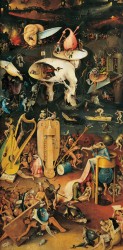
McGrath 1968
“Satan and Bosch. The Visio Tundali and the monastic vices” (Robert L. McGrath) 1968
[in: Gazette des Beaux-Arts, vol. 110, nr. 1188 (January 1968), pp. 45-50]
[Also mentioned in Gibson 1983: 94 (E126)]
Most scholars interpret the monster devouring sinners and excreting them through a transparent bubble in the right interior wing of the Garden of Delights as a representation of Satan. There are, however, a lot of objections to this view. Roggen related the monster to certain passages in the Visio Tundali. Recent interpretations acknowledge the Visio Tundali as the source of Bosch’s monster but at the same time the identification of the creature with Satan is retained. However, many scholars have failed to take into account that there are various episodes in the vision dealing with the punishment of sinners by digestion.
Two episodes are often cited: the one in which Satan is described and another concerning the monster Acherons, infernal tormentor of the avaricious. But neither passage can explain what Bosch painted. More interesting is the passage describing a monster that punishes the unchaste clergy by devouring them and excreting them into a frozen pool. This passage is depicted in a miniature from a French Visio Tundali manuscript made for Margaret of York, Duchess of Burgundy, in 1474. This miniature shows strong affinities with what Bosch painted. For Bosch the Visio Tundali was merely a point of departure for nowhere in the text do we find the night-stool, the cauldron-hat or the wine-jug buskins.
By virtue of the connection with the Visio Tundali the group of figures beneath the night-stool can correctly be understood within the given context. Mateo’s assertion that these personages represent the sin of Luxuria is not consistent with Bosch’s own established use of symbols. It is more logical that this group refers to sins to which an intemperate clergy is most susceptible, more particularly to the monastic vices of Luxuria, Gula and Avaritia. The woman looking in the mirror-behind of a monster refers to Superbia (most authors agree about this). The man defecating coins refers to Avaritia, the vomiting man refers to Gula and the sleeping man with a toad on his chest refers to Luxuria. The sinister women around his bed are lustful and licentious nuns.
Conclusion: the entire group beneath the night-stool and the monster in the night-stool itself function in the total painting as a condemnation of clerical excesses and as a reminder of the resultant punishments in the afterlife.
A question could be: if these sinners are clerics, why don’t they have a tonsure? Moreover: that the she-devils around the bed represent nuns, is highly improbable.
[explicit]